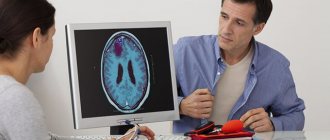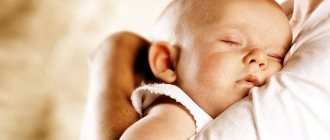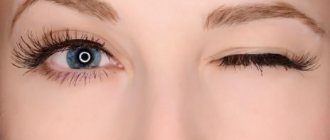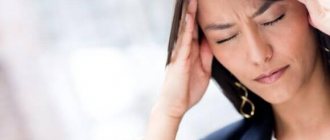Etiology and pathogenesis of narcolepsy
Scientists have not yet been able to establish the exact causes of narcolepsy. For a long time, it was believed that the etiology of the disease was closely related to mental disorders. However, this theory was not confirmed. Nowadays, a theory is being actively researched that proves that the disease occurs due to a lack of a neurotransmitter, which is responsible for maintaining wakefulness. Namely, a biologically active substance, the deficiency of which leads to narcolepsy, may be hypocretin. This deficiency may be genetically determined or occur in cases of severe fatigue, severe infection, pregnancy, or traumatic brain injury.
Another theory proves the autoimmune mechanism of pathology. Proof of this theory is that abnormal T lymphocytes are found in patients with narcolepsy. In addition, the autoimmune origin of the pathology is evidenced by the onset of its development after vaccination or the detection of infectious diseases (measles, influenza). No more is known about the pathogenesis of the pathology than about its origin. Scientists suggest that the main problem of the disease is the untimeliness of the REM sleep phase - it is introduced both during the waking period and the slow-wave sleep phase.
Causes of narcolepsy
The causes of narcolepsy have long remained unclear. Various versions of the origin of the disease have been put forward, including some surprising ones (one German neurologist believed that the cause of narcolepsy was teenage masturbation). Some neurologists spoke about the psychosomatic origin of the disease, others considered it a manifestation of schizophrenia, and others considered the cause to be disturbances in the neurochemical balance of the brain.
The true cause of narcolepsy was discovered quite recently, at the end of the twentieth century, it lies in the “breakdown” of the system that triggers the REM (paradoxical) sleep phase.
Our brain is a very complex “mechanism”. Even in Pavlov's laboratories it was proven that it contains deep structures responsible for sleep. There are also biologically active chemicals that facilitate the conduction of nerve impulses through neurons - neurotransmitters (neurotransmitters). When the human nervous system functions correctly, then thanks to these substances we are in a non-sleeping state. But if there is a lack of them, the excitation impulses do not reach the neurons and the person falls asleep. Thus, extensive research has made it possible to establish the most plausible cause of narcolepsy, which lies in the lack of certain types of neurotransmitters - orexin A and orexin B. The function of orexins is to maintain a state of wakefulness, and their lack is the cause of narcolepsy.
A breakdown of the REM sleep system and, accordingly, a lack of orexin is provoked by:
- brain injuries;
- infectious brain lesions;
- excessive fatigue;
- pregnancy;
- unstable emotional state, psychological trauma;
- malfunctions of the immune system;
- hormonal imbalance;
- diabetes;
- genetic predisposition.
In many cases, the cause of narcolepsy, that is, the factor that provoked paradoxical sleep disorder, remains unclear.
Symptoms of Narcolepsy
The clinical picture of the disease includes four main symptoms: daytime sleepiness, cataplexy, hypnagogic hallucinations and insomnia. Typically, patients experience several of these symptoms at the same time; all four symptoms are diagnosed at once in 10% of cases.
- Daytime sleepiness
- Cataplexy
- Hypnagogic hallucinations
- Sleep paralysis
A patient with narcolepsy experiences several bouts of irresistible drowsiness throughout the day. Such attacks can be either single or multiple. The duration of attacks ranges from several minutes to a couple of hours. The patient is practically unable to resist sudden falling asleep, but he can be woken up in the same way as during normal sleep. In most cases, attacks occur in a monotonous environment, which can cause drowsiness in a healthy person (reading, watching TV).
The patient can also fall asleep in critical situations that require increased attention (while eating, talking, driving a car). After waking up, the patient often feels rested and alert, but after a couple of minutes he may fall asleep again. Night sleep in patients with narcolepsy is often fragmented and accompanied by nightmares, resulting in low productivity and performance during the day. Patients experience decreased motivation, poor concentration, and may experience depression. Patients with narcolepsy are susceptible to increased trauma.
This condition is characterized by sudden muscle weakness and paralysis caused by emotional reactions such as joy, fear, anger, surprise. Weakness can manifest itself in one limb or be generalized. In the latter case, after emotional impact, the patient suddenly collapses. Cataplexy is observed in a third of all patients with narcolepsy.
People with narcolepsy may experience unusual visual and auditory hallucinations while falling asleep. They resemble overly vivid dreams that occur during REM sleep. Most often, such illusions bother children. In adult patients, hallucinations are diagnosed extremely rarely.
A quarter of all patients with narcolepsy suffer from sleep paralysis. This is a transient muscle weakness that occurs when falling asleep or waking up. It does not allow the patient to make voluntary movements. Patients usually feel intense fear due to the inability to move.
Symptoms
Typically, the first signs of narcolepsy are observed between the ages of 10 and 25 years. Symptoms vary greatly from one person to another, but the core symptoms of narcolepsy remain the same: excessive daytime sleepiness and abnormal REM sleep. Other symptoms are also associated with sleep disturbances. These include sleep paralysis, hallucinations and cataplexy. Narcolepsy is highly dependent on the emotional state and is more pronounced when a person experiences strong emotions.
| Symptoms | Symptom name | Characteristic |
| Main | Excessive daytime sleepiness | This condition usually appears first in people suffering from narcolepsy. Patients fall asleep while talking, driving, eating, or at other inappropriate times. Severe drowsiness occurs despite a full night's sleep and persists throughout the day. Patients also complain of mental retardation, lack of energy, low concentration, memory loss, depressed mood, extreme nervous and physical exhaustion. |
| Cataplexy | This condition is characterized by a sudden loss of muscle tone caused by emotional stimuli (such as laughter, surprise, or anger). This leads to a feeling of general weakness and loss of muscle control. Cataplexy is often accompanied by symptoms such as slurred speech, general body relaxation, or weakness of certain muscle groups (for example, in the knees or arms). Consciousness is usually preserved, but the patient is unable to speak. | |
| Hallucinations | These delusional experiences can be very vivid and bizarre, and therefore can frighten the patient. Their content is mainly visual, but other senses may also be involved. If hallucinations accompany falling asleep, they are called hypnagogic, and when they occur during awakening, they are called hypnopompic. | |
| Sleep paralysis | This is the name given to a person’s temporary inability to speak and move when falling asleep or waking up. These episodes are short-lived, lasting from a couple of seconds to a couple of minutes. Then the patient quickly and completely restores all his abilities. | |
| Additional | Restless night's sleep | The patient wakes up repeatedly during the night. This condition is accompanied by kicking, nightmares and general motor restlessness. |
| Microsleep | These are brief episodes of sleep when a person continues to function (talk, eat, etc.). If you wake him up, he does not remember what he was doing at that moment. | |
| Night wakefulness | The patient may be awake at night, which is accompanied by hot flashes and increased heart rate. | |
| Instant entry into REM sleep | The patient enters the dreaming phase immediately after falling asleep, whereas ordinary people require about 90 minutes for this. Thus, patients experience vivid dreams and muscle paralysis early in sleep, even if they fall asleep during the day. |
Diagnosis of narcolepsy
It is not possible to diagnose a patient with narcolepsy immediately; on average, the diagnosis is made 10 years after the onset of the disease. Patients who complain of symptoms characteristic of narcolepsy are examined by a neurologist. It must be taken into account that the disease is similar in its clinical manifestations to many other neurological pathologies. That is why, for the most accurate diagnosis, consultations with such specialists as a psychiatrist, endocrinologist, epileptologist, infectious disease specialist, and gastroenterologist may be required.
Treatment methods
The disease is completely untreatable. But you can reduce the number of daytime sleep fragments and reduce nighttime activity. Get rid of hallucinations and cataplexy.
Among the medications, psychostimulant drugs have proven themselves, such as:
- Modafinil,
- Sidnokarb,
- Meridil,
- Indopan.
Eliminate daytime sleepiness.
To improve night rest, sleeping pills are prescribed. Although they are ineffective for this kind of disorder.
To get rid of cataplexy and hallucinations, antidepressants are taken.
The most effective are considered:
- Imipramine;
- Clomipramine;
- Melipramine;
- Tofranil;
- Anafranil.
Medicines are prescribed in courses to avoid addiction syndrome.
The disease is still poorly understood and, without medical examination, Gelineau's disease is difficult to prevent. But following generally accepted recommendations, it is possible not to worsen the situation.
- sleep hygiene. Drawing up a schedule and constantly following it will help adjust the body to a certain rhythm and alleviate the patient’s condition;
- physical training. Regular exercise will help improve your health. Just don’t overuse physical activity in the evening; it’s better to move it to the morning or lunch;
- alcohol and caffeine. Avoid drinking alcohol and energy drinks, they only create an imaginary wakefulness in your body;
- stress. Try to avoid stressful situations and scandals at home, which not only spoil your emotional state, but also undermine your health. Treat everything superficially;
- fragmentation of cases. Break important big tasks into small and simple ones with a short period of time. It will be easier for you to concentrate on small tasks.
But the world does not stand still, and in recent decades medicine has been moving forward with great strides.
For example, American scientists have already developed a spray containing orexin, which has already been tested on animals and has shown good results. Perhaps, in a short time, we will be able to obtain an effective medicine against this serious illness.
Polysomnography - the first thing to do
Before starting treatment, a diagnosis is performed. Polysomnography will help to find out the causes of sleep disturbances; research is also being carried out to identify breathing disorders. Next, the necessary medications are selected, drugs that are most effective in eliminating symptoms. Therapy will help actively combat nighttime sleep disturbances and daytime falling asleep.
Sleep pathology has a unique clinical picture. Treatment for narcolepsy depends on the symptoms. In case of pathology, the effect of sleeping pills is not effective enough. For daytime sleepiness, the following are recommended:
- Meridil;
- Indopan;
- Modafinil;
- Sidnocarb.
The dosage of psychostimulants is prescribed individually. A treatment course of 2-3 weeks is required. After a short period of time, the therapy is repeated.
The use of tricyclic antidepressants helps eliminate the manifestations of cataplexy. The drugs Clomipramine and Imipramine are prescribed. It is advisable to use a serotonin reuptake inhibitor in therapy; fluoxetine is prescribed for this purpose. Various amphetamine-based stimulants are also used to normalize sleep.
It is known that today new drugs in the form of nasal sprays are being actively developed to help the patient quickly compensate for the lack of neurotransmitters in the body.
The disease is lifelong, so the prescribed treatment only alleviates the course of the disease and eliminates symptoms. There is a constant need to take prescribed medications. Medicines can have various side effects, which aggravates the situation.
Although there is no cure for narcolepsy, some symptoms can be controlled with medications and lifestyle changes. If cataplexy is present in the disease, the decrease in hypocretin levels is considered irreversible and chronic. Excessive daytime sleepiness and cataplexy can be controlled in most people with medications.
Medications
Modafinil. The initial stage of treatment usually involves stimulation of the central nervous system, using a drug such as modafinil. Modafinil is usually prescribed first because it is less addictive and has fewer side effects than older stimulants. In most patients, the drug is generally effective in reducing daytime sleepiness and increasing alertness.
Amphetamine-like stimulants. In cases where modafinil is not effective, drugs such as methylphenidate may be prescribed to relieve symptoms. However, these medications should be carefully monitored because they may have side effects such as irritability and nervousness, tremors, heart rhythm problems, and trouble sleeping at night.
Antidepressants. In the fight against cataplexy in most patients, two classes of antidepressants have proven effective: tricyclic antidepressants (imipramine, desipramine, clomipramine and protriptyline) and selective serotonin and noradrenergic reuptake inhibitors (venlafaxine, fluoxetine and atomoxetine).
Sodium oxybate. Sodium oxybate (also known as gamma-hydroxybutyrate or GHB) is effective in treating cataplexy and excessive daytime sleepiness in people with narcolepsy. This is a strong sedative that must be taken twice daily. Due to safety concerns associated with the use of this drug, the use of sodium oxybate is strictly limited. Along with other salts, GHB is included in the list of psychotropic substances (list III), the circulation of which is limited in Russia.
Differential diagnosis
It is necessary to differentiate narcolepsy first of all from epilepsy. The symptoms of the pathology are also similar to the clinical picture of other types of hypersomnia: psychophysiological, post-traumatic (provoked by a traumatic brain injury, the presence of an intracerebral hematoma), psychopathic (occurs against the background of mental disorders such as schizophrenia or hysteria), associated with inflammatory, tumor or vascular, cerebral diseases, caused by somatic pathologies (diabetes mellitus, pernicious anemia, hypothyroidism, liver failure).
Polysomnography
The disease can be diagnosed using polysomnography, which is accompanied by EEG recording and MSLT test. An in-depth and most accurate study of pathology is carried out by a somnologist in the laboratory. The polysomnography technique involves a thorough study of the patient's night sleep. To do this, you need to spend the whole night in a specially designed room under the supervision of a doctor. Using this technique, it is possible to detect a violation of the alternation of sleep phases: an increase in the duration and frequency of the REM sleep phase. The technique also allows you to eliminate similar sleep disorders.
MSLT test
The day after the polysomnography, the doctor may prescribe an MSLT test for the patient. Namely, the patient will need to try to fall asleep five times during the day. The interval between periods of short-term sleep should be about 2-3 hours. After conducting an MSLT test, a doctor can make a diagnosis if at least two sleep episodes are confirmed. For a more accurate study of the disease, the doctor may prescribe periods of hidden drowsiness. Differential diagnosis of narcolepsy involves the following diagnostic measures: ophthalmoscopy, duplex scanning, MRI of the brain, ultrasound of cerebral vessels.
Sleeping mode
Treatment of patients with narcolepsy should begin with normalizing their sleep and wakefulness patterns. It is strongly recommended that you go to bed and wake up at the same time. Almost all patients are shown the following sleep regimen: 7-8 hours of night sleep and two periods of daytime sleep from 15 minutes to half an hour. It is also important to take care of the quality of your sleep. To do this, you should avoid overeating, eating heavy food, and drinking alcohol in the evening.
In addition, patients should change their lifestyle: reduce the impact of stressful situations, significantly reduce the use of stimulants (coffee or nicotine), and begin to actively engage in sports. Often, people with narcolepsy experience a disruption in their biological clock, so they are active at night and feel sleepy during the day. For them, choosing a job that coincides with their natural sleep cycle would be ideal. Such a regime will allow you to get rid of the need to force your body to adhere to a standard operating mode and take stimulant drugs to eliminate drowsiness.
Patients with narcolepsy are advised to take short naps during the day. It is very important to plan your day so that you can take a 10-15 minute nap at least twice. Such sleep cannot fully replace nighttime sleep, but it will help overcome daytime sleepiness.
Treatment
Narcolepsy is an incurable disease; treatment is aimed at eliminating symptoms. Full recovery of the patient is impossible. The main goal of therapy is to improve the patient’s well-being and quality of life. To increase physical and mental activity during the daytime, stimulant drugs from the amphetamine group, as well as non-amphetamine psychostimulants (Pemoline), are used.
Narcolepsy responds well to treatment with the analeptic (eliminating drowsiness) Modafinil, but its use is limited by side effects that are poorly tolerated by many patients. Modafinil is considered the drug of first choice. Its effect is due to an increase in the concentration of dopamine in the striatum, norepinephrine in the hypothalamus, and serotonin in the cortical parts of the frontal lobes and the amygdala.
Among the adverse events that occur after Modafinil therapy, it is worth noting allergic reactions, including nasal congestion, shortness of breath, skin manifestations (excessive rashes, ulcers on the oral mucosa), psychoneurological disorders, increased levels of anxiety, and a feeling of restlessness.
The most dangerous side effects are swelling that occurs in the face, throat, limbs, and impaired swallowing and breathing functions. Treatment of narcolepsy in Russia due to the unavailability of Modafinil is carried out with serotonin uptake inhibitors (Fluoxetine, Sertraline).
To eliminate the manifestations of cataplexy, tricyclic antidepressants (Venlafaxine, Clomipramine) and anticonvulsants (Carbamazepine) are prescribed. Nighttime sleep disorders are treated with hypnotics (Imidazopyridine, Cyclopyrrolone, Zopiclone). The experimental drug JZP-110 (dopamine uptake inhibitor) helps cope with daytime sleepiness and increases the level of daytime wakefulness.
A significant role in complex therapy is played by routine measures - restoration of normal night sleep, daytime sleep lasting 15 minutes, avoidance of stress, correction of body weight. Patients are advised not to work on a shift schedule.
Drug treatment
Drug treatment of patients with mild or moderate drowsiness begins with the administration of modafinil, which stimulates wakefulness. At the same time, the drug does not cause a feeling of euphoria or addiction syndrome. It is recommended to take it in the morning in an amount of 100-200 mg orally. If this amount of the drug is not enough to relieve the symptoms of the disease, then the doctor will additionally prescribe another 100 mg. In the most difficult situations, according to indications, the daily dose can be increased to 400 mg.
If narcolepsy does not respond to treatment with modafinil, then the patient is prescribed amphetamine derivatives: methylphenidate or dextroamphetamine. However, it must be remembered that these medications have serious side effects: addiction with a high risk of addiction, tachycardia, arterial hypertension. To reduce the incidence of cataplexy, patients with narcolepsy are prescribed the following drugs: serotonin reuptake inhibitors (Prozac), tricyclic antidepressants (anafranil and tofranil).
Diagnosis and treatment
Diagnosis of narcolepsy consists of a general assessment of the patient’s condition, as well as the use of polysomnography and the MSLT test. When interviewing and examining the patient, other diseases that manifest similar symptoms are excluded or confirmed. The likelihood of pathology is high if the patient experiences the following symptoms:
- attacks of drowsiness during the daytime;
- sudden weakness, falling during strong emotions;
- visions, hallucinations when falling asleep, as well as waking up;
- paralysis of the body upon awakening.
If two or more symptoms appear, you should be immediately examined and tested.
Polysomnography is a test in which small electrodes are attached to the patient's skin. They are attached using an adhesive substance. Electrodes record heart rhythm, muscle activity, intracerebral waves, and eye movements. The test results allow us to determine the characteristics of the course of the disease.
Then the MSLT test is performed, it is prescribed the day after the polysomnography. Here, electrodes are also attached to the body, but the patient must sleep. This may require several attempts at intervals of two hours. The dream lasts about twenty minutes. After these tests, the doctor makes an accurate diagnosis.
Important! Narcolepsy is not completely curable. This is despite all the modern advances in medicine. However, proper treatment will reduce the number of daytime sleep attacks, hallucinations and loss of muscle tone, as well as improve night rest.
In order to eliminate drowsiness during the day, the analeptic drug Modafinil is prescribed. It is used at 100 or 200 mg in the morning. If this dosage is not enough (drowsiness occurs during the day), then an additional 100 mg is prescribed.
The second dose must be taken no later than 13:00. Additional doses of the drug are not recommended, as its use carries the risk of night sleep disturbance. Modafinil does not cause addiction.
Narcoleptics are treated with drugs called psychostimulants. Sidnocarb (20 to 50 mg per day), Meridil (up to 30 mg per day), Indopan (30 to 60 mg per day) are used.
They are prescribed in courses that should last up to one month. These medications are then gradually withdrawn (up to three weeks). To normalize good sleep at night, sleeping pills are prescribed, but in narcolepsy they have rather low effectiveness.
In order to eliminate attacks of hallucinations, as well as cataplexies, antidepressants are used. The most effective among them are: Clomipramine (25 to 150 mg) and Imipramine. They are taken once - in the morning. Antidepressants help to almost completely eliminate attacks.
In parallel with the use of medications, it is possible to use some medicinal plants to eliminate the symptoms of narcolepsy. Hops have a good relaxing effect. Its ground cones must be poured with boiling water, infused, and then strained. Drink one quarter glass before meals. The same infusions can be made from motherwort, chamomile, dill or lemon balm.
Recently, scientists have conducted many studies. At this stage, an American specialist is developing a nasal spray based on orexin. It is possible that soon, thanks to this development, narcolepsy will become a completely curable disease.
Treatment of narcolepsy involves compliance with certain rules, which are also preventive measures to prevent the occurrence of attacks. Among them are:
- Maintain a clear sleep schedule. Go to bed and get up at the same time. Try not to sleep during the day.
- Avoid nicotine and alcohol products.
- Avoid consuming caffeine and heavy foods, especially before bed.
- It is recommended to move more and play sports.
- Follow your diet.
Important! Patients with narcolepsy should never drive a car or work at heights, as if they fall asleep they can harm not only themselves, but also those around them.
Forecast and prevention of narcolepsy
To date, narcolepsy has no cure. As for the prognosis for the patient’s life, the disease does not affect its duration, but significantly reduces its quality. Patients who suffer from narcolepsy are prescribed symptomatic therapy. With the help of properly selected drug therapy, you can get rid of the most pronounced symptoms of the pathology. However, it is worth remembering that taking such drugs sometimes leads to side effects. There is no specific prevention of the disease, since the exact causes of its occurrence have not yet been identified.
Treatment of narcolepsy
Currently, there is no effective treatment for narcolepsy. It was and remains a chronic disease that lasts a lifetime. Treatment is aimed solely at controlling narcolepsy “attacks” and trying to reduce their number. It is important to try to improve the patient's quality of life, allow him to work and maintain social activity. In order to prevent injuries, it is necessary to abandon certain types of activities associated with danger to the patient and others.
Use of drugs to treat narcolepsy
The following groups of medications are widely used:
- Stimulants. They eliminate drowsiness and allow patients to feel better during the daytime.
- Antidepressants. The use of tricyclic antidepressants reduces catalepsy, sleep paralysis and hallucinations.
- Sleeping pills. Prolongs and stabilizes night sleep.









